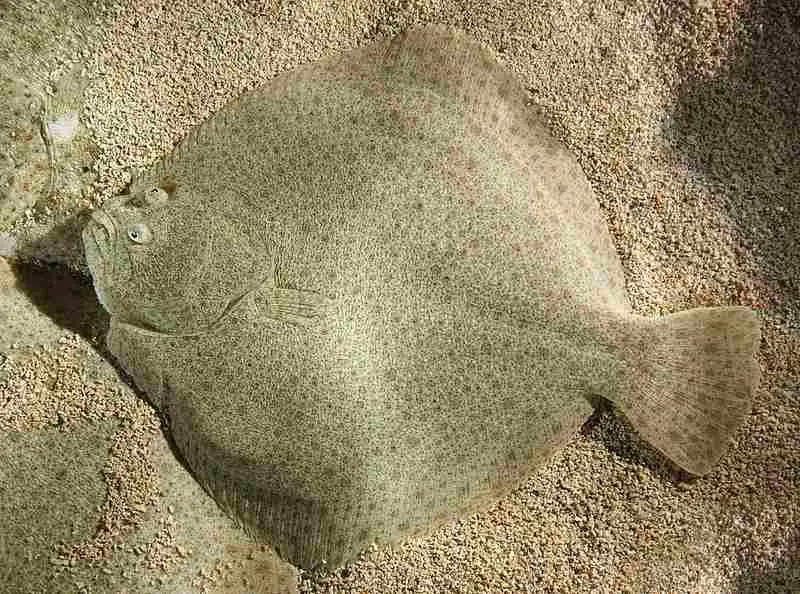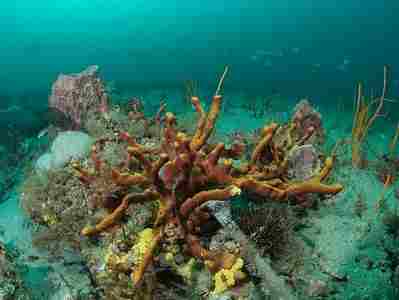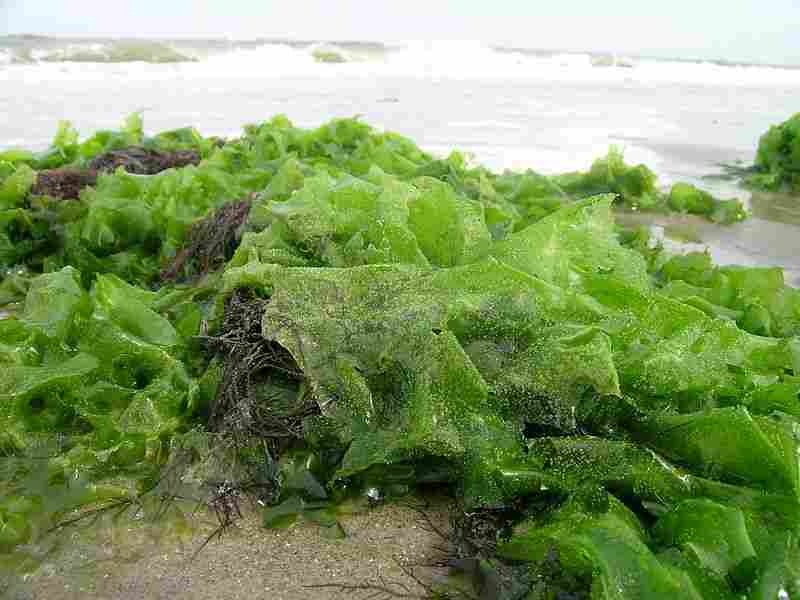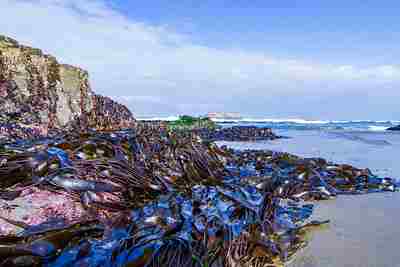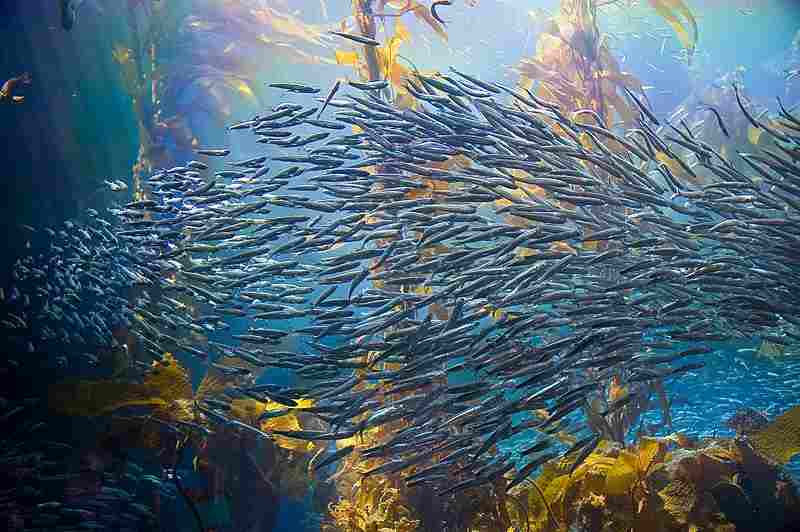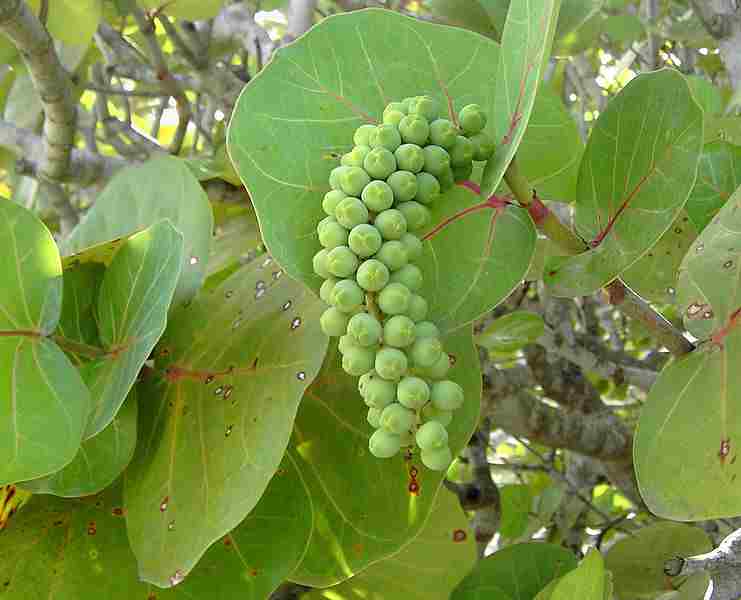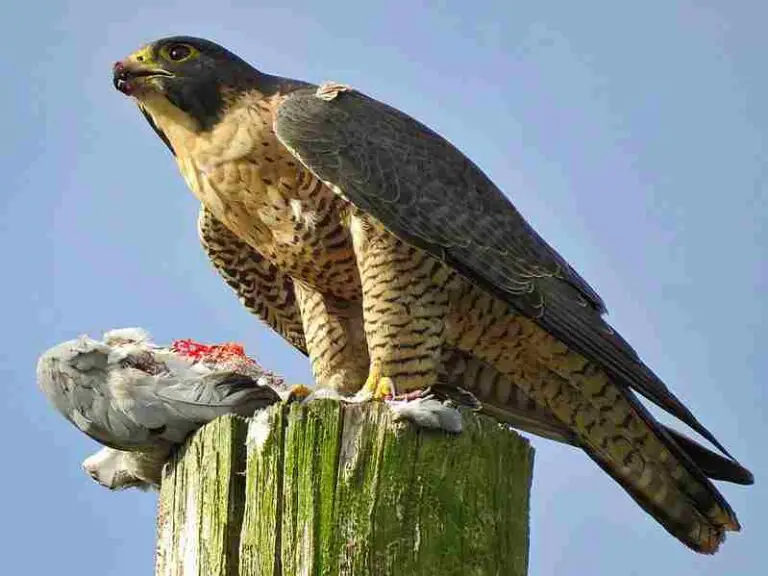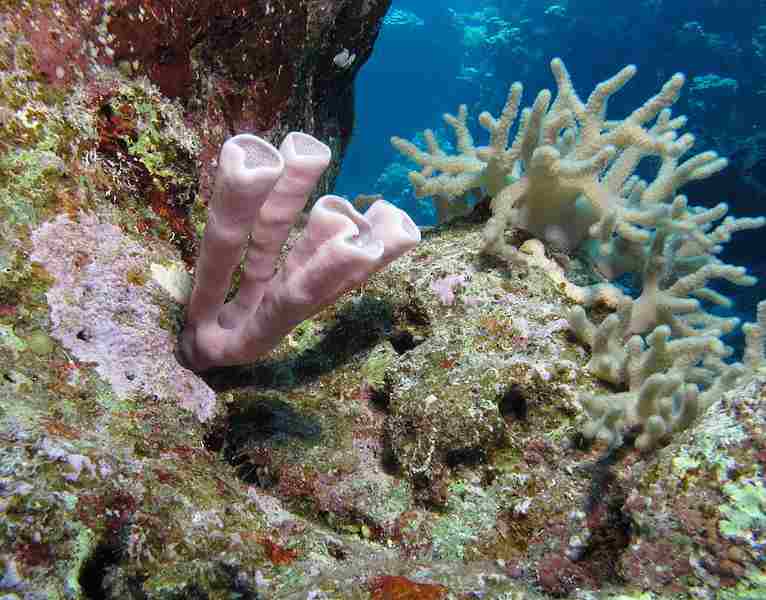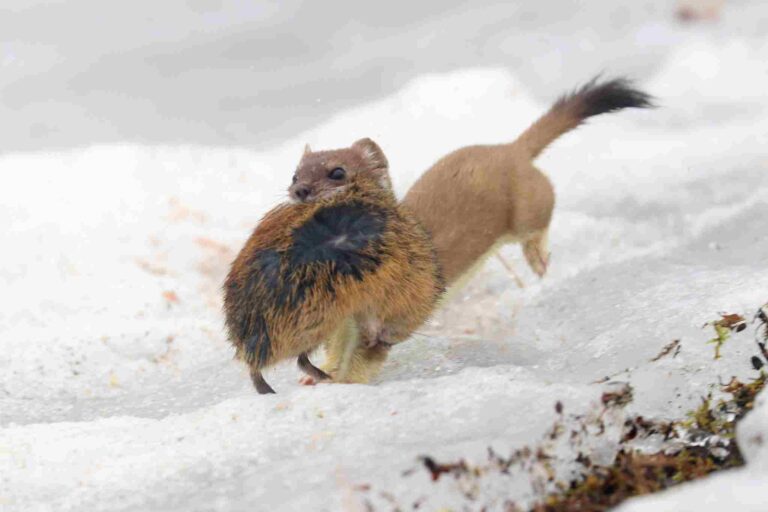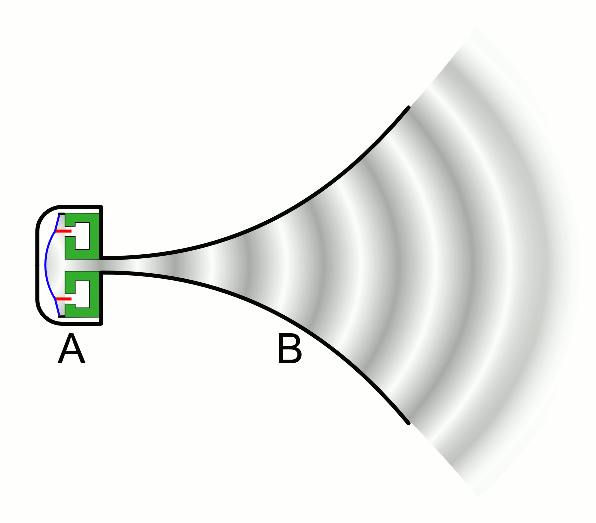11+ Animals and Plants in the Benthic Zone
Animals in the Benthic Zone include; corals, sponges, sea urchins, sea stars, polychaete worms, crabs, caddisfly larvae, Giant Pacific octopus. and leopard shark.
Plants in the Benthic Zone include; mangrove trees, and seagrasses like eelgrass, shoal grass and turtle grass. Other autotrophs in the benthic zone include brown algae like kelp, green algae like sea lettuce, and some red algae species.
This article discusses animals and plants in the benthic zone, as outlined below;
-Animals in the Benthic Zone
Animals in the benthic zone include; corals, sponges, sea urchins, sea stars, polychaete worms, crabs, caddisfly larvae, Giant Pacific octopus, ans leopard shark.
1). Corals: A Class of Animals in the Benthic Zone
Corals are marine organisms found in the benthic zone, mainly in tropical and subtropical oceans.
Key characteristics and functions of corals include their; calcium carbonate skeletons, symbiotic relationships, support of biodiversity, ecosystem services, filter feeding behavior, sensitivity to environment changes, reproductive strategies, and contributions to tourism and recreation.
Corals secrete hard skeletons of calcium carbonate, forming the structural units of coral reefs.
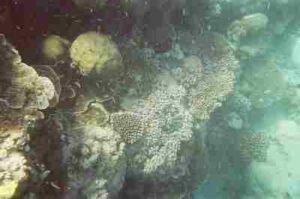
Many corals have a symbiotic relationship with photosynthetic algae called zooxanthellae, which provide bioenergy through photosynthesis and contribute to the vibrant colors of coral.
Coral reefs support high regional species richness and biodiversity, providing habitats for a myriad of marine species, including fish, invertebrates, and microorganisms.
Also, corals are highly instrumental in shoreline protection by reducing wave energy, preventing coastal erosion, and supporting marine fisheries that are vital for human populations.
Some corals are filter feeders which extract plankton and organic matter from the water, contributing to nutrient cycling in the marine environment.
Corals are highly sensitive to changes in temperature, water quality, and pollution, making them vulnerable to coral bleaching and disease. This makes conserving and protecting the benthic zone an important practice.
Corals reproduce both sexually, through the release of gametes, and asexually, through budding and fragmentation, contributing to the resilience and growth of coral colonies.
Lastly, coral reefs attract tourism and recreational activities, generating economic value for coastal ecosystems and communities.
It can be deduced from the above that, corals in the benthic zone are vital components of marine ecosystems, providing ecological and economic benefits while being sensitive indicators of environmental health.
2). Sponges in the Benthic Zone
Sponges, or poriferans, are simple aquatic animals residing in the benthic zone.
Their main characteristics and functions include; filter feeding, possession of collagenous skeleton, asexual reproduction, biodiversity support, chemical defenses, role as ecological indicators, habitat engineers, and facilitators of nutrient-recycling.
Sponges are filter feeders, drawing in water through specialized cells and extracting biogenic particles, bacteria, and sedimentary detritus for nutrition.
Typically, sponges possess a flexible collagenous skeleton or spicules, providing structural support to their soft body.
Sponges reproduce asexually through fragmentation, where small pieces can develop into new individuals, contributing to their population growth.
Also, sponges create microhabitats, offering shelter to various small marine organisms, and contributing to the overall sustenance of benthic zone biodiversity.
Some sponges produce bioactive compounds that serve as chemical defenses against both predators and competitors, making them important in the pharmaceutical and biomedical fields.
Sponges are sensitive to changes in water quality and can act as indicators of environmental health in marine ecosystems.
Some species of sponges contribute to the formation of hard-bottom habitats, providing substrates for other organisms in the benthic zone.
Sponges play an effective role in nutrient cycling by recycling organic waste and contributing to the long-term availability of marine resources.
Based on the above discussion, sponges in the benthic zone are essential in various areas including nutrient cycling, biodiversity support, and habitat formation, making them important contributors to the ecological trends of marine environments.
3). Sea Urchins: An Example of Animals in the Benthic Zone
Sea urchins are marine echinoderms found in the benthic zone.
Some characteristics and functions of benthic sea urchin are; possession of endoskeleton, herbivorous feeding habit, tube feet, asexual reproduction strategies, bioturbation effects, role in ecological engineering, predation and defense mechanisms.
Sea urchins have a hard, calcareous endoskeleton composed of interlocking plates, which provide protection and structure.
Most sea urchins have a predominantly herbivores diet, grazing on algae as well as detritus with their specialized mouthparts, contributing to the regulation of benthic primary producers.
Tube feet on the underside of sea urchins help them in locomotion, attachment to substrates, and manipulation of food particles.
Sea urchins reproduce sexually, releasing eggs and sperm into the water, and their larvae typically undergo a planktonic phase before settling on the benthic substrate.
Some sea urchin species can cause significant biotic disturbance by overgrazing, which leads to the creation of barren areas in the benthic zone.
Also, sea urchins can modify their environment by creating pits and depressions in the substrate through their feeding and burrowing activities.
Sea urchins possess spines for defense against predators, and some species exhibit behaviors such as hiding in crevices during the day to avoid predation.
Lastly, sea urchins are important prey for various marine organisms, and contribute to the dynamic of energy transfer in the marine food web.
In summary, sea urchins play crucial roles in benthic ecosystems through herbivorous feeding, ecological engineering, and serving as both prey and predators, influencing the balance and dynamics of marine communities.
4). Sea Stars in the Benthic Zone
Sea stars, or starfish, are marine invertebrates commonly found in the benthic zone.
The characteristics and functions of sea stars include; radial symmetry, possession of water vascular system, predatory feeding behavior, regeneration, asexual reproduction, contribution to echinoderm diversity, role as keystone species, and ecosystem engineering function. Below are more details;
Typically, sea stars exhibit radial symmetry, with arms radiating from a central disk, enabling efficient movement and feeding.
Sea stars have a unique water vascular system that powers tube feet, used for locomotion, attachment, and capturing prey.
Also, sea stars are predators, which primarily feed on small invertebrates like mollusks,, and detritus. They use their tube feet to pry open shellfish and optimize feeding efficiency.
Sea stars have remarkable regenerative abilities, being capable of regrowing lost arms or even the entire body under certain conditions.
Some sea star species can reproduce asexually by splitting their central disk, resulting in the formation of new individuals.
As part of the diverse echinoderm phylum, sea stars contribute to the overall organic diversity of the benthic zone.
In some ecosystems, sea stars act as keystone species by significantly influencing the population of certain prey (and predator) species, thereby influencing community structure.
Sea stars can impact their environment by controlling the abundance of other benthic organisms, influencing the diversity and composition of the community.
Generally, sea stars have crucial contributions to the benthic ecosystem, which they make through their predatory feeding habits, unique anatomy, regenerative abilities, and influence on community structure, so that they can be correctly described as significant contributors to marine biodiversity.
5). Polychaete Worms: An Example of Animals in the Benthic Zone
Polychaete worms are a group of segmented marine worms that are commonly found in the benthic zone.
The key characteristics and functions of polychaete worms in the benthic zone include; segmented body, benthic habitat preference, distinctive feeding strategies, burrowing behavior, reproductive diversity, sediment stabilization role, biological indication, and contribution to predator-prey dynamics.
Polychaetes have a distinct, segmented body with bristle-like structures referred to as chaetae, which provide mobility and traction.
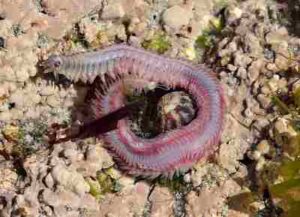
Polychaetes inhabit a wide range of benthic habitats, from shallow coastal areas to deep-sea environments, contributing to overall benthic biodiversity.
Polychaetes exhibit diverse feeding strategies, including filter feeding, scavenging, and predation, contributing to nutrient cycling in the benthic ecosystem.
Many polychaetes are burrowers, creating tubes or burrows in sediments, influencing sediment structure, and promoting oxygenation.
Polychaetes display various reproductive strategies, including both sexual and asexual reproduction, enhancing their adaptability and population dynamics.
Through burrowing activities, polychaetes contribute to sediment stabilization, affecting the physical characteristics of the benthic substrate.
Some polychaetes are used as bioindicators, reflecting changes in environmental conditions, such as pollution or habitat degradation.
Polychaetes serve as both prey and predators in the benthic food web, participating in the transfer of energy within marine ecosystems.
In benthic ecosystems, polychaete worms are essential biotic components, contributing to habitat diversity, nutrient cycling, sediment dynamics, and also serving as valuable indicators of environmental vitality.
6). Crabs in the Benthic Zone
Crabs are crustaceans which commonly occur in the benthic zone.
Their characteristics and functions include; possession of a rigid exoskeleton, cephalothorax structure, benthic habitat selectivity, omnivorous diet, burrowing behavior, distinctive mating and reproduction strategies, ecological interactions, and environmental sensitivity.
Crabs possess a hard exoskeleton that provides protection and support, and also serves as a framework for muscle attachment.
The body of a crab is typically divided into a cephalothorax and abdomen, with ten limbs, including claws (chelae) which are used for various functions.
Crabs inhabit a diverse range of benthic environments, which include intertidal zones and deep-sea floors, thereby showcasing adaptability to different conditions.
Also, crabs are omnivores, feeding on a variety of items, including detritus, algae, small invertebrates, and carrion, and contributing effectively to localized nutrient cycling.
Many crab species are burrowers, which create shelters in the sediment that influence habitat structure and provide protection.
Crabs exhibit diverse mating behaviors, and females often carry eggs until they hatch, contributing to population dynamics.
In their habitat, crabs engage in complex ecological interactions, serving as both predators and prey in the benthic food web, and influencing community structure.
Lastly, like other benthic organisms, crabs are sensitive to environmental changes, making them valuable indicators of ecosystem health and ocean pollution levels.
Crabs generally play integral roles in benthic ecosystems through their diverse diet, burrowing activities, reproductive strategies, and ecological interactions, which contribute to the overall functionality and stability of marine environments.
7). Caddisfly Larvae: An Example of Animals in the Benthic Zone
Caddisfly larvae are aquatic insects that are often part of the organic community in the benthic zone.
Some characteristics and functions of the caddisfly include; aquatic larval stage; protective cases, herbivorous and detritivorous diet, sensitivity to water quality, multiple ecological roles, metamorphosis, biotic interactions, and ecosystem health indication.
Caddisflies have an aquatic larval stage, residing in freshwater habitats, particularly in streams and rivers.
Also, caddisfly larvae construct protective cases using silk and various fragmentary materials such as stones, sand, or plant parts, offering camouflage and protection from predators.
The larvae of caddisfly are primarily herbivores, which graze on algae and plant matter, or detritivores, which consume decaying organic material, in both cases contributing to nutrient cycling.
Caddisfly larvae are notably sensitive to changes in water quality, making them bioindicators for assessing the health of freshwater ecosystems.
Important roles are played by caddisfly larvae in nutrient dynamics and energy flow within aquatic ecosystems, serving as a link between primary producers and consumers in higher trophic levels.
Caddisflies usually undergo complete metamorphosis, transitioning from the aquatic larval stage to terrestrial adults, which contributes to ecosystem connectivity between aquatic and terrestrial biomes.
In aquatic environments, caddisfly larvae engage in interactions with other benthic organisms, serving as both prey and predators in the aquatic food web.
The presence, abundance, and diversity of caddisfly larvae can all provide valuable information about the ecological integrity of freshwater systems.
Generally, caddisfly larvae can be said to contribute to processes like nutrient cycling, habitat construction, and to also serve as indicators of freshwater ecosystem health, have essential functions within the benthic zone of aquatic environments.
8). Giant Pacific Octopus in the Benthic Zone
The Giant Pacific Octopus is a cephalopod found in the benthic zone.
Characteristics and functions of the Giant Pacific Octopus are; adaptability, effective camouflage, intelligence, predatory feeding habits, distinctive reproductive strategy, propulsive movement, use of tools, and multiple ecological roles.
Being highly adaptable, the Giant Pacific Octopus can thrive in a variety of benthic environments, ranging from rocky reefs to soft sedimentary beds.
Also, possessing sophisticated color-changing abilities, it uses camouflage for hunting, avoiding potential predators, as well as for communication.
Considered one of the most intelligent invertebrates, the Giant Pacific Octopus exhibits problem-solving skills and complex behaviors.
An opportunistic predator, it preys on crustaceans, fish, and mollusks, using its beak to crack open protective structures like shells.
Exhibiting semelparity, females lay a large number of eggs, guard them, and die after hatching, a phenomenon which influences their population dynamics.
The Giant Pacific Octopus uses jet propulsion by expelling water through a siphon, enabling swift and agile movement in the benthic environment.
It is known for using tools, such as coconut shells, for shelter and protection, showcasing advanced cognitive abilities.
Lastly, the Giant Pacific Octopus plays a vital role in controlling prey populations, contributing to the balance of the benthic ecosystem.
The above discussion shows that the Giant Pacific Octopus is a highly adaptable, intelligent predator with remarkable behaviors, influencing the ecological dynamics of the benthic zone through its feeding habits and ecological interactions.
9). Leopard Shark: An Example of Animals in the Benthic Zone
Leopard Sharks are elasmobranchs that can be found in the benthic zone, particularly in coastal waters.
Key characteristics and functions of Leopard Sharks include; distinctive appearance, nocturnal feeding behavior, reproductive gathering, repetitive migratory patterns, elongated tail, multiple ecosystem functions, and ecologic resilience.
Recognizable by its leopard-like spots and slender body, the Leopard Shark has a distinct appearance.
Also, Leopard Sharks primarily dwell near the ocean floor, and are well-adapted to the benthic zone, favoring sandy or muddy substrates.
Exhibiting nocturnal feeding behavior, Leopard Sharks forage for crustaceans, small fish, and bottom-dwelling mollusks across the benthic landscape.
Leopard Sharks are known to gather in specific coastal areas for mating and pupping, contributing to the species' reproductive cycle.
Displaying seasonal migrations, Leopard Sharks often transit between shallow coastal waters and deeper benthic zones.
Also, the long, slender tail of the Leopard Shark aids in efficient movement and navigation in the benthic environment.
As both predators and prey, Leopard Sharks play a role in maintaining the balance of the benthic ecosystem by controlling small prey populations.
Lastly, Leopard Sharks exhibit resilience to varying environmental impacts and conditions, adapting effectively to changes in temperature and habitat availability.
It can be derived from the above that Leopard Sharks are adapted to the benthic zone, where they display unique behaviors and contribute to the ecological dynamics of coastal environments through their feeding habits and role in the oceanic food web.
-4 Main Groups of Benthic Animals
The four (4) main groups of benthic animals are; endobenthos, epibenthos, hyperbenthos, and transitional benthic animals.
1). Endobenthos: One of the Main Groups of Benthic Animals
Endobenthos refers to animals that live within the sediment or substrate of the benthic zone.
These organisms have crucial contributions which they make to the ecological functioning of marine environments.
The sand dollar serves as an example of an endobenthic organism. Major characteristics and ecological functions include; morphological adaptation, distinctive feeding strategies, oxygen transport, substrate disturbance, habitat modification, ecosystem engineering, and indicator species role.
Endobenthic animals, like sand dollars, typically have flattened bodies with adaptations for burrowing into sediments.
Sand dollars are detritivores which feed on organic particles and detritus found in the sediment, contributing to nutrient cycling.
Endobenthic organisms often exhibit burrowing behavior, creating tunnels or chambers within the sediment for shelter and protection.
Specialized structures, such as tube feet and respiratory appendages, aid in oxygen exchange for animals like sand dollars that live within the sediments.
The burrowing activities of endobenthos contribute to substrate disturbance, affecting sediment structure and influencing the distribution of other benthic organisms.
Endobenthic organisms, including sand dollars, modify their habitat by creating burrows, potentially also providing refuge or microhabitats for other small organisms.
Through their burrowing and feeding activities, endobenthic animals are instrumental as ecosystem engineers, which influence the physical and chemical characteristics of the benthic environment.
Changes in the abundance and behavior of endobenthic organisms, like sand dollars, can serve as indicators of environmental health and sediment quality.
The endobenthos, exemplified by sand dollars, contributes significantly to nutrient cycling, habitat modification, and ecosystem continuity in the entire benthic zone. Their burrowing activities play a crucial role in shaping the structure and function of marine environments.
2). Epibenthos
Epibenthos refers to organisms that live on or just above the seafloor or sedimentary substrate in the benthic zone. This diverse group includes various animals.
Examples of epibenthos are; sea anemones, sea urchins, sponges, corals, and grass shrimp, which individually and collectively showcase the characteristics and ecological functions of epibenthic organisms.
Here, they are discussed in terms of their body forms, sessile and motile characteristics, feeding strategies, habitat formation role, ecosystem engineering, biotic interactions, reproductive strategies, and environmental sensitivity.
Epibenthic organisms exhibit diverse body forms. Sea anemones have a simple cylindrical body with tentacles, sea urchins have a spiny spherical body, sponges have porous structures, corals form colonies with polyps, and grass shrimp have relatively elongated bodies.
While some epibenthic organisms are sessile (that is; attached to the substrate), like sea anemones and corals, others are motile, such as sea urchins and grass shrimp, allowing for movement across the seafloor.
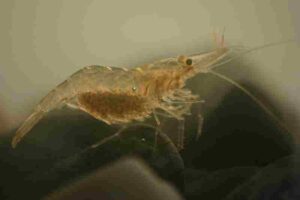
Epibenthic organisms employ various feeding strategies. Sea anemones are predatory, using tentacles to capture prey. Sea urchins have a largely herbivorous diet, grazing on both micro and macro-algae. Sponges are filter feeders, and corals have a symbiotic relationship with zooxanthellae, gaining nutrients through photosynthesis. Grass shrimp are omnivores, consuming algae, biogenic detritus, and small invertebrates.
Corals and some sponges contribute to habitat formation by creating complex structures like coral reefs, that provide shelter for numerous marine species.
Epibenthic organisms, particularly corals and sponges, act as ecosystem engineers by influencing habitat structure, water flow patterns, and trends of nutrient cycling.
Sea anemones, sea urchins, and grass shrimp engage in biotic interactions such as predation and symbiosis, thereby influencing community dynamics in the benthic environment.
Epibenthic organisms exhibit diverse reproductive strategies. Corals reproduce both sexually and asexually. Sea urchins release eggs and sperm into the water for external fertilization. Sponges reproduce through fragmentation, while grass shrimp have complex reproductive behaviors.
Many epibenthic organisms, especially corals, are sensitive to environmental changes, making them usable as indicators of ecosystem health.
Generally, epibenthic organisms contribute to the complexity and biodiversity of the benthic zone, playing essential roles in nutrient cycling, habitat formation, and ecological interactions within marine ecosystems.
3). Hyperbenthos: One of the Main Groups of Benthic Animals
Hyperbenthos refers to organisms that inhabit the water column just above the seafloor in the benthic zone. Like others, this group includes a variety of animals.
Examples of hyperbenthos or hyperbenthic organisms are; rock cods, copepods, highfin goby, and banded killfish. These examples highlight the individual and collective characteristics and ecological functions, of hyperbenthic communities.
Below is an outline of the body adaptations, active swimming capabilities, feeding strategies, vertical migrations, reproductive strategies, food source provision, ecological connectivity, and role in pelagic-benthic coupling, of hyperbenthic organisms;
Hyperbenthic organisms often have streamlined or specialized body structures to navigate the water column efficiently. Rock cods, for example, have elongated bodies, and copepods exhibit various body structures for swimming.
This implies that many hyperbenthic organisms, such as copepods, are highly mobile and actively swim in the water column, allowing them to exploit resources efficiently.
Hyperbenthic organisms display diverse feeding strategies. Rock cods are carnivorous, preying on smaller organisms. Copepods are often herbivorous or omnivorous, consuming phytoplankton, detritus, as well as other small heterotrophs. Highfin goby and banded killfish are opportunistic feeders, consuming a variety of food materials.
Some hyperbenthic organisms, like copepods, engage in vertical migrations, moving between different depths in the water column to optimize feeding, avoid predators, or participate in reproductive activities.
Various reproductive strategies are exhibited by hyperbenthic organisms. Copepods, for instance, undergo complex life cycles with multiple developmental stages, which contribute to population dynamics.
Hyperbenthic organisms may serve as important prey for marine or freshwater consumers in higher trophic levels, thereby establishing a link between the lower trophic levels (phytoplankton) and larger predators in the marine food web.
Also, hyperbenthic organisms contribute to the ecological connectivity of marine ecosystems by transferring energy and nutrients between different benthic and pelagic compartments.
Lastly, hyperbenthic organisms, through their movements and feeding habits, contribute effectively to the coupling of pelagic and benthic ecosystems, thereby influencing nutrient cycling and community structure.
It can be deduced from the above explanation, that hyperbenthic organisms play vital roles in the dynamics of the benthic zone and the water column, contributing to nutrient cycling, energy transfer, and serving as essential sustainers of aquatic food chains.
4). Transitional Benthic Animals
Transitional benthic animals exhibit attributes that encompass characteristics of more than one major benthic group, including epibenthos, endobenthos, and hyperbenthos.
These organisms display versatile adaptations which allow them to inhabit and interact with various niches within the benthic environment. Their adaptability often involves a combination of traits associated with surface-dwelling (epibenthic), burrowing (endobenthic), and actively swimming (hyperbenthic) lifestyles.
Examples of transitional benthic animals may showcase traits such as streamlined bodies for swimming, burrowing capabilities, and the ability to reside on or near the seafloor.
Their versatility enables them to navigate and exploit resources across different zones within the benthic environment, contributing to the biodiversity and ecological dynamics of marine ecosystems.
It must however be noted that examples of organisms within this group are subjective, as the classification criteria will vary from one study or context to another.
-What Benthic Animals Eat
Benthic organisms feed on material like detrital organic waste, inorganic soft sediments, and microbial organisms.
1). Detrital Organic Waste/Remains: An Example of What Benthic Animals Eat
Detrital organic waste or remains serve as a significant food source for benthic animals in marine ecosystems.
This organic material comprises of decaying plant and animal matter, fecal pellets, and other debris that settle to the seafloor.
Some important aspects of the role of detrital organic waste as a food source for benthic animals include; nutrient cycling, detritivore sustenance, bottom-feeding fish dietary supplementation, microbial decomposition, energy transfer, habitat provision, seasonal variability, and ecosystem resilience.
Detritus is rich in both organic matter and nutrients. Benthic animals have a crucial role to play in nutrient recycling, by breaking down and consuming detrital material, in the process releasing essential nutrients back into the ecosystem.
Benthic organisms specialized in detritus consumption, known as detritivores, include various invertebrates such as worms, some crustaceans, and mollusks. These organisms are adapted to process and extract nutrients from organic waste material.
Some bottom-feeding fish, such as certain species of flatfish and catfish, rely on detrital organic waste as part of their diet. They forage within the benthic zone, consuming both detritus and small invertebrates associated with the decomposing organic matter.
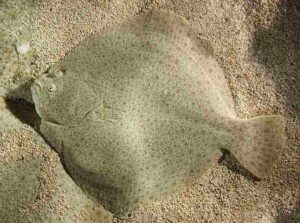
Detritus facilitates microbial decomposition, whereby complex organic compounds are broken down and transformed into simpler products. Bacteria and fungi play a vital role in this process, and may leave partially degraded byproducts that are subsequently consumed by benthic animals.
Detrital organic waste is an important energy source at the base of the food web in the benthic environment. Benthic organisms that feed on detritus transfer energy to others in higher trophic levels, contributing to the overall productivity of the ecosystem.
Accumulations of detritus on the seafloor can also create some microhabitats, providing shelter for small invertebrates while serving as a substrate for detritivorous benthic organisms.
The availability of detrital organic waste can vary seasonally, influencing the feeding behaviors and life cycles of benthic animals that rely on this resource.
Benthic animals that consume detritus contribute to the resilience, resourcefulness, and stability of marine ecosystems by efficiently recycling organic matter, regulating nutrient dynamics, and supporting the survival of benthic communities.
Generally, detrital organic waste is an important component of the benthic food web, supporting a diverse array of organisms and playing a critical role in nutrient cycling as well as energy transfer within marine ecosystems.
2). Inorganic Soft Sediments
Inorganic soft sediments, such as mud, silt, and sand, serve as essential food sources for a variety of benthic animals in marine ecosystems. These sediments may lack organic material visible to the unaided eye, but are usually rich in microorganisms, detritus, and dissolved substances.
Important factors that define of the role of inorganic soft sediments as a food source for benthic animals, include; deposit feeding processes, microbial decomposition, bioturbation, sediment ingestion, filter feeders, habitat provision for burrowers; energy availability, and benthic community structuring.
Benthic organisms known as deposit feeders are adapted to extract organic particles and microorganisms from inorganic soft sediments. Examples include certain species of worms, mollusks, and crustaceans.
Soft sediments are a site of microbial activity, where bacteria and fungi decompose organic matter, releasing nutrients that benthic organisms can utilize for their growth.
Benthic animals that feed on inorganic soft sediments engage in bioturbation, the process of influencing and altering the sediment structure. This activity promotes oxygenation of sediments and also enhances nutrient cycling.
Some benthic animals ingest sediments as part of their feeding strategy. After extracting organic material and microorganisms, they usually expel the indigestible particles, influencing sediment composition.
Certain bivalve mollusks, like clams, are filter feeders that extract organic particles and microorganisms from the water column, including those suspended above inorganic soft sediments.
Inorganic soft sediments provide habitats for burrowing benthos such as worms and crustaceans. These animals construct burrows for shelter and access to organic material within the sediments.
Inorganic soft sediments contribute significantly to the supply of energy sources for many benthic animals, especially those adapted to feeding on particles and microorganisms present in the sediment matrix.
The availability and composition of inorganic soft sediments influence the structure and distribution of benthic communities, defining the diversity and relative abundance of organisms in the benthic zone.
In organic soft sediments are generally instrumental in supporting the nutrition and energy needs of benthic animals. The complex interactions between sediment composition, microbial activity, and the feeding strategies of benthic organisms contribute to the overall ecological dynamics of marine ecosystems.
3). Microbial Organisms: An Example of What Benthic Animals Eat
Microbial organisms represent a critical and often overlooked food source for various benthic animals in marine ecosystems.
These microorganisms, including bacteria and fungi, also have essential roles to play in nutrient cycling, organic matter decomposition, and overall ecosystem functioning.
The discussion of microbial organisms as a food source for benthic animals here addresses concepts like microbial decomposition, detritus feeders, symbiotic relationships, filter feeding, bacterial mats, nitrogen fixation, bioturbation, and microbial loop.
Bacteria and fungi contribute to the decomposition of organic matter, by breaking down complex organic compounds to yield simpler materials. Benthic animals, especially detritivores, feed on the byproducts of microbial decomposition, often along with the microbes that facilitate this process.
Benthic organisms, such as worms, crustaceans, and mollusks, specialize in feeding on detritus enriched with microbial organisms. These detritivores extract nutrients released during microbial decomposition.
Some benthic animals engage in symbiotic relationships with microbes. For example, certain species of sponges play host to microbial communities that aid in the digestion of organic particles, thereby providing a nutritional source for the sponge.
Filter-feeding benthic organisms, including some species of clams and sponges, extract microbial organisms from the water column, contributing to their nutritional intake.
Bacterial mats on sediments or hard surfaces in the benthic zone serve as a food source for organisms such as small invertebrates and certain types of fish that graze on these microbial communities.
Microbial organisms are also contributors to nitrogen fixation, by converting atmospheric nitrogen into forms usable by marine organisms. Benthic animals, including those involved in nutrient cycling, benefit from the availability of nitrogen in microbial processes.
Benthic organisms that engage in bioturbation, such as burrowing species of worms and crustaceans, enhance microbial activity by oxygenating sediments. This activity creates microhabitats that attract microbial organisms and contribute to the overall food web.
The microbial loop in marine ecosystems involves the transfer of energy and nutrients from microbes to higher trophic levels, including benthic animals. This loop is a critical component of nutrient cycling and supports the productivity of benthic communities.
Microbial organisms serve as a foundational food source for benthic animals, influencing nutrient dynamics, community structure, and overall ecosystem health in the marine benthic zone. The intricate interactions between benthic organisms and microbial communities contribute to the resilience and productivity of these ecosystems.
-Plants in the Benthic Zone
Plants in the benthic zone are mangrove trees, and seagrasses like; eelgrass, shoal grass, and turtle grass.
1). Mangrove Trees: An Example of Plants in the Benthic Zone
Mangrove trees are unique and highly adaptive plants that thrive in the intertidal zones of tropical and subtropical coastal regions. Their characteristics and functions make them vital components of the benthic zone, providing numerous ecological benefits.
The key characteristics of mangrove trees are; salt tolerance, possession of aerial roots, viviparous propagation, tolerance to aerobic conditions, dense canopy structure, bark and leaf adaptations.
Mangroves are adapted to high salinity levels, possessing specialized mechanisms to exclude or excrete salt. Some species even have salt-filtering roots.
Many mangrove species develop specialized aerial root systems and organelles, such as pneumatophores, which enable oxygen exchange in waterlogged sediments, where the oxygen concentration is low.
Mangroves often exhibit viviparous reproduction, where seeds germinate while still attached to the parent tree. This adaptation enhances seedling survival in the challenging intertidal environment.
Also, mangroves can tolerate periods of waterlogging/flooding and anaerobic conditions in the sediment, thanks to adaptations like lenticels and specialized root structures.
The canopy of mangrove trees provides shade, reducing the impact of intense sunlight on the benthic zone and creating a viable microhabitat beneath the canopy.
Mangrove species have waxy bark and leaves to minimize water loss and prevent excess salt absorption.
Functions of mangrove trees in the benthic zone include; coastal protection, habitat provision, carbon sequestration, nutrient cycling, economic application, and water filtration.
Mangroves act as a natural buffer, protecting coastlines from erosion and storm surges by reducing the magnitude of incoming wave energy. Their extensive root systems stabilize sediments.
Also, mangroves provide critical habitats for a diverse array of marine and terrestrial species, including fish, crustaceans, mollusks, and numerous bird species. They serve as nurseries for many marine organisms.
In carbon sequestration, mangrove ecosystems have a significant role to play. They store large amounts of carbon both above and below ground, helping mitigate climate change.
Mangrove trees contribute to nutrient cycling by trapping and processing organic matter from the land and sea, influencing the nutrient composition of the surrounding benthic zone.
For local communities, mangroves are economically valuable. They support fisheries, provide various vegetative products, while contributing to ecotourism.
The intricate root systems of mangroves filter pollutants from the water, improving water quality in coastal ecosystems.
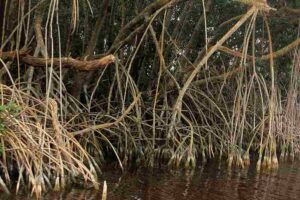
Mangroves can adapt to rising sea levels by migrating landward, maintaining their important functions as a protective barrier and habitat.
Generally, mangrove trees exemplify the remarkable adaptation of plants to the benthic environment, playing pivotal roles in coastal protection, biodiversity support, and ecosystem services essential for both marine life and human communities.
2). Seagrasses as Plants in the Benthic Zone
Seagrasses represent a major group of plants in the benthic zone.
Examples of seagrasses that can be found in the benthic zone are; Eelgrass, Shoal Grass, and Turtle Grass. Each of them is discussed below;
1. Eelgrass (Zostera spp.)
Characteristic features of eelgrass include their blades, rhizomes, flowers, and habitat preference. They are outlined below;
Long, ribbon-like blades with a distinct midrib.
Extensive rhizome system anchoring the plant in sediments.
Small, inconspicuous flowers on long stems.
Thrives in sheltered coastal areas with sandy or muddy substrates.
Functions of eelgrass in the benthic zone are; habitat and nursery provision, sediment stabilization, nutrient cycling, and carbon sequestration. Below are additional details;
Provides habitat and serves as a nursery for various marine organisms.
Stabilizes sediments with its rhizome network, preventing erosion.
Contributes to nutrient cycling by trapping and processing organic matter.
Plays a role in carbon sequestration, mitigating climate change impacts.
2. Shoal Grass (Halodule wrightii)
Characteristics of shoal grass include; short and narrow blades, possession of rhizomes, and distinctive flowers. The following outline reiterates these and more;
Short, narrow blades in a distinctive "W" shape.
Creeping rhizomes spreading horizontally in the sediment.
Small, inconspicuous flowers with short stalks.
Common in shallow, sandy areas of tropical and subtropical regions.
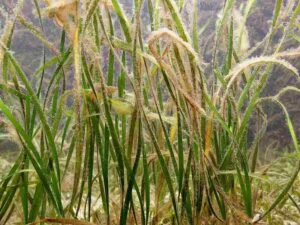
Functions of turtle grass in the benthic zone include; erosion control, habitat and food provision, water quality improvement, and support of benthic communities.
Helps stabilize sediments and control erosion in shallow coastal areas.
Provides habitat for various marine species and serves as a food source.
Contributes to water clarity by trapping sediments and nutrients.
Supports diverse benthic communities, influencing local biodiversity.
3. Turtle Grass (Thalassia testudinum)
Characteristics of turtle grass include the possession of elongate, flat blades, extensive rhizomes, small flowers, and preference for specific substrates. These are simplified in the following list;
Long, flat blades with prominent veins.
Extensive rhizome system forming large meadows.
Small, greenish-white flowers on long stalks.
Thrives in sandy and muddy substrates in shallow coastal areas.
Functions of turtle grass in the benthic zone include; habitat engineering, erosion reduction, food provision, and carbon storage, as outlined below;
Provides critical habitat and serves as a nursery for various marine organisms, including juvenile fish and invertebrates.
Stabilizes sediments, reducing erosion and maintaining water clarity.
Offers a food source for herbivorous marine organisms.
Contributes to carbon sequestration, helping mitigate climate change.
As the above assessment shows, these seagrasses, including Eelgrass, Shoal Grass, and Turtle Grass, exhibit unique attributes and play critical roles within the benthic zone, contributing to habitat formation, sediment stabilization, nutrient cycling, and supporting diverse marine ecosystems.
Other Autotrophs in the Benthic Zone
Other autotrophs in the benthic zone are; brown algae (such as kelp), green algae (like sea lettuce), as well as red algae (like Gelidium chilense).
1. Brown Algae like Kelp in the Benthic Zone
Brown algae in the benthic zone can be characterized by their color and pigments, size and growth form, habitat and distribution, cell wall composition, reproduction, sporophyte and gametophyte phases, photosynthetic adaptations, ecological roles, and economic importance.
1a. Color and Pigments
Brown algae derive their name from the distinctive brown coloration resulting from pigments like fucoxanthin.
Besides chlorophyll, brown algae contain accessory pigments that enable them to efficiently capture light energy for photosynthesis.
1b. Size and Growth Form
Brown algae, particularly kelps, are among the largest algae, with some species reaching considerable lengths, forming underwater "forests."
Typically, brown algae have a complex thallus (body) structure, often differentiated into holdfasts, stipes, and blades, contributing to their overall morphological diversity.
1c. Habitat and Distribution
Brown algae, including kelp, are primarily benthic, attaching to the seafloor with specialized structures like holdfasts.
Commonly found in subtidal zones, especially in cold, nutrient-rich waters along coastlines.
1d. Cell Wall Composition:
Brown algae have cell walls composed of cellulose and alginates, providing structural support and flexibility.
1e. Reproduction
Brown algae typically exhibit alternation of generations, with a complex life cycle involving both haploid and diploid phases.
The sporophyte phase produces spores, while the gametophyte phase produces gametes for sexual reproduction.
1f. Photosynthetic Adaptations
Brown algae have adaptations to low light conditions, allowing them to photosynthesize effectively in deeper waters where light penetration is reduced.
Kelps often store carbohydrates in the form of laminarin, providing an energy reserve.
1g. Ecological Roles
Brown algae, especially kelps, create habitats and shelters for a diverse array of marine organisms, contributing to local biodiversity.
As primary producers, brown algae play a crucial role in marine food webs by converting solar energy into organic matter.
1h. Economic Importance
The economic important of brown algae lies in their commercial uses.
Brown algae, such as certain kelp species, have economic importance for various uses, including food (alginate extraction), fertilizers, and as a source of bioactive compounds.
In general, brown algae like kelp exhibit unique characteristics that make them well-suited for life in the benthic zone. Their large size, complex morphology, and ecological roles contribute to the biodiversity and functioning of marine ecosystems.
2. Green Algae like Sea Lettuce in the Benthic Zone
Attributes of green algae in the benthic zone can be discussed in terms of their color and pigmentation, size and morphological form, habitat ans distribution, cell wall composition, reproduction, photosynthetic adaptations, ecological roles, ecologic and culinary importance.
2a. Color and Pigmentation
Green algae, as the name suggests, are predominantly green due to the presence of chlorophyll.
Green algae contain chloroplasts with chlorophyll a and b, as well as other pigments like beta-carotene.
2b. Size and Growth Form
Significant morphological variability is a core characteristic of green algae in the benthic zone.
Green algae exhibit a wide range of sizes, from microscopic unicellular forms to macroscopic multicellular species.
Growth forms vary, including filamentous, sheet-like, or thallus structures.
2c. Habitat and Distribution
Green algae can be found in various aquatic environments, including benthic zones in freshwater and marine ecosystems.
Some species, like sea lettuce, may thrive in intertidal zones, attaching to rocky substrates.
2d. Cell Wall Composition
The cell walls of green algae are primarily composed of cellulose, providing structural support.
2e. Reproduction
The reproductive strategies of benthic green algae include alternation of generations, as well as asexual and sexual reproduction.
Green algae typically undergo alternation of generations, with haploid and diploid phases in their life cycle.
Reproduction can occur through both asexual means, such as spore formation, and sexual means, involving gamete production.
2f. Photosynthetic Adaptations
Possession of photosynthetic pigments, and adaptation to specific light conditions, are features of benthic green algae.
Besides chlorophyll, green algae may contain additional pigments that broaden their capacity to capture light for photosynthesis.
Green algae are adapted to various light conditions, with some species capable of adjusting to changes in light intensity.
2g. Ecological Roles
Primary production and oxygen cycling are major ecological roles of green algae in the benthic zone.
As primary producers, green algae contribute significantly to the base of the aquatic food web, converting sunlight into organic matter.
Green algae play a crucial role in oxygen production through photosynthesis.
2h. Economic and Culinary Importance
Some green algae, including certain species of sea lettuce, have economic importance for uses like agar production and as a culinary ingredient in various cuisines.
Generally, green algae like sea lettuce exhibit a wide range of characteristics adapted to life in the benthic zone. Their ecological roles as primary producers, ability to adapt to various light conditions, and economic significance contribute to their importance in aquatic ecosystems.
3. Red Algae like Gelidium chilense in the Benthic Zone
Characteristic aspects of red algae in the benthic zone include their coloration, size and growth form, habitat and distribution, cell wall attributes, reproduction, photosynthetic adaptations, role(s) in ecosystem sustenance, and commercial applicability. Each of these is discussed below;
3a. Color and Pigments
Distinctive coloration and accessory pigments are both features of red algae.
Red algae are characterized by their red to purplish coloration, attributed to the dominance of pigments such as chlorophyll a, phycocyanin, and phycoerythrin.
Red algae often contain additional accessory pigments that expand their ability to capture light energy for photosynthesis.
3b. Size and Growth Form
Diversity of size and multicellularity can be attributed to benthic red algae.
Red algae exhibit a diverse range of sizes, from small, filamentous forms to larger, complex structures.
Most red algae are multicellular, forming thalli with differentiated structures.
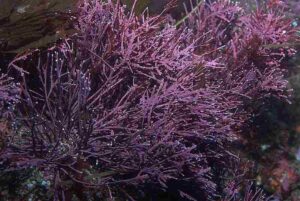
3c. Habitat and Distribution
Red algae are primarily benthic, attaching to substrates through holdfasts.
Many red algae, including Gelidium chilense, thrive in subtidal zones, often at significant depths.
3d. Cell Wall Composition
Red algae have cell walls composed of cellulose and unique polysaccharides like agar, which has commercial applications.
3e. Reproduction
Red algae typically undergo alternation of generations, with distinct haploid and diploid phases.
Reproduction involves specialized structures such as cystocarps (containing female gametes) and tetrasporangia (containing spores).
3f. Photosynthetic Adaptations
Red algae are adapted to low light conditions, which allow them to thrive in deeper waters where other pigments, such as phycoerythrin, are advantageous.
The presence of unique pigments contributes to the efficiency of light absorption and photosynthesis.
3g. Ecological Roles
Formation of benthic habitats and provision of food sources are both ecological roles of red algae.
Red algae, including Gelidium chilense, contribute to the formation of benthic habitats by attaching to substrates and creating complex structures.
Many species of red algae serve as food sources for various marine organisms, contributing to local biodiversity.
3h. Economic Importance
Certain red algae, like Gelidium chilense, are commercially valuable for agar production, which is used in various industries, including food, pharmaceuticals, and cosmetics.
In general, red algae, exemplified by Gelidium chilense, exhibit unique characteristics adapted to life in the benthic zone. Their red coloration, multicellularity, ecological roles, and economic significance contribute to their importance in marine ecosystems and human industries.
Conclusion
Animals in the benthic zone are;
Corals
Sponges
Sea Urchins
Sea Stars
Polychaete Worms
Crabs
Caddisfly Larvae
Giant Pacific Octopus
Leopard Shark
The four (4) main groups of benthic animala are;
Endobenthos
Epibenthos
Hyperbenthos
Transitional Benthic Animals
Materials which benthic animals feed on include;
Detrital Organic Waste/Remains
Inorganic Soft Sediments
Microbial Organisms
Plants in the benthic zone are;
Mangrove Trees
Seagrasses like; eelgrass, shoal grass, and turtle grass
Other autotrophs in the benthic zone are;
Brown Algae like Kelp
Green Algae like Sea Lettuce
Red Algae like Gelidium chile
